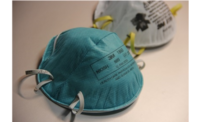A respirator can't protect you if it doesn't fit your face. Certain respirators, known as tight-fitting respirators, must form a tight seal with your face or neck to work properly, according to OSHA. If your respirator doesn't fit your face properly, contaminated air can leak into your respirator facepiece, and you could breathe in hazardous substances.
Before you wear a tight-fitting respirator, your employer must ensure that your respirator fits you. This is done by performing a fit test on you while you wear the same make, model, and size of respirator that you will be using on the job.
In addition, before you use a respirator or are fit-tested, your employer must ensure that you are medically able to wear it.
So what is a fit test? A “fit test” tests the seal between the respirator's facepiece and your face. It takes about 15 to 20 minutes to complete and is performed at least annually, per OSHA requirements. After passing a fit test with a respirator, you must use the exact same make, model, style, and size respirator on the job.
OSHA notes that a fit test should not be confused with a user seal check. A user seal check is a quick check performed by the wearer each time the respirator is put on. It determines if the respirator is properly seated to the face or needs to be readjusted.
There are two types of fit tests: qualitative and quantitative.
Qualitative fit testing
Qualitative fit testing is a pass/fail test method that uses your sense of taste or smell, or your reaction to an irritant in order to detect leakage into the respirator facepiece. Qualitative fit testing does not measure the actual amount of leakage. Whether the respirator passes or fails the test is based on you detecting leakage of the test substance into your facepiece. There are four qualitative fit test methods accepted by OSHA:
- Isoamyl acetate, which smells like bananas;
- Saccharin, which leaves a sweet taste in your mouth;
- Bitrex, which leaves a bitter taste in your mouth; and
- Irritant smoke, which can cause coughing.
Qualitative fit testing is normally used for half-mask respirators - masks that just cover your mouth and nose. Half-mask respirators can be filtering facepiece respirators - often called “N95s” — as well as elastomeric respirators.
Quantitative fit testing
Quantitative fit testing uses a machine to measure the actual amount of leakage into the facepiece and does not rely upon your sense of taste, smell, or irritation in order to detect leakage. The respirators used during this type of fit testing will have a probe attached to the facepiece that will be connected to the machine by a hose. There are three quantitative fit test methods accepted by OSHA:
- Generated aerosol;
- Ambient aerosol; and
- Controlled Negative Pressure.
Quantitative fit testing can be used for any type of tight-fitting respirator.
Fit test caveats
Many workers need to wear prescription glasses or personal protective equipment, such as safety goggles or earmuffs, while performing a job. If you fall into this category, then you must wear these items during the fit test to be sure they don't interfere with the respirator's fit.
You must be fit tested before you use a respirator in the workplace, and you must be retested at least every 12 months to make sure that the respirator you use still fits you. You must be fit tested with the specific make, model, style, and size of respirator that you will be using.
Not everyone can get a good fit with one specific respirator. If the respirator fails the fit test, then another make, model, style, or size must be tried until one is found that fits you properly. Your employer needs to provide you with a reasonable selection of sizes and models to choose from. When you've completed the fit testing process, it's very important that you know which make, model, style, and size respirator fits your face properly, and when and where you'll need to wear it for protection.
Also, the fit of your respirator must be retested whenever you have a change in your physical condition that could affect the fit of you respirator. Such changes could include:
- large weight gain or loss;
- major dental work (such as new dentures);
- facial surgery that may have changed the shape of your face; or
- significant scarring in the area of the seal.
Any of these changes could affect the ability of your respirator to properly seal to your face, which could allow contaminated air to leak into your respirator facepiece, according to OSHA.
If you find that the fit of your respirator becomes unacceptable, you must be allowed to select a different type of respirator and be retested. The selection may include a new make, model, style, or size of respirator.
Facial hair, like a beard or mustache, can affect your respirator's ability to protect you, according to OSHA. Anything that comes between your face and the respirator's seal or gets into the respirator's valves can allow contaminated air to leak into the respirator facepiece and you will not be protected. For example, if you have long hair, make sure it doesn't get between the respirator seal and your face because this can allow contaminated air to leak into the respirator, states OSHA.
New fit test protocols
Any person may submit to OSHA an application for approval of a new fit test protocol. If the application meets the following criteria, OSHA will initiate a rulemaking proceeding under section 6(b)(7) of the OSH Act to determine whether to list the new protocol as an approved protocol in this Appendix A.
The application must include a detailed description of the proposed new fit test protocol. This application must be supported by either:
- A test report prepared by an independent government research laboratory (e.g., Lawrence Livermore National Laboratory, Los Alamos National Laboratory, the National Institute for Standards and Technology) stating that the laboratory has tested the protocol and had found it to be accurate and reliable; or
- An article that has been published in a peer-reviewed industrial hygiene journal describing the protocol and explaining how test data support the protocol's accuracy and reliability.
If OSHA determines that additional information is required before the agency commences a rulemaking proceeding under this section, OSHA will notify the applicant and afford the applicant the opportunity to submit the supplemental information. Initiation of a rulemaking proceeding will be deferred until OSHA has received and evaluated the supplemental information.
Sponsor: www.rpbsafety.com 866-494-4599


